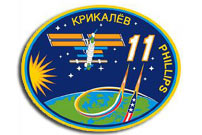NASA Space Station On-Orbit Status 16 May 2005

SpaceRef note: This NASA Headquarters internal status report, as presented here, contains additional, original material produced by SpaceRef.com (copyright © 2005) to enhance access to related status reports and NASA activities.
All ISS systems continue to function nominally, except those noted previously or below. Underway: Week 4 for Increment 11.
|
Shuttle |
Both crewmembers had three hours set aside for a major IFM (in-flight maintenance) on the TVIS (treadmill with vibration isolation & stabilization), replacing both the forward and aft gyroscope wire ropes. This required first removing the treadmill from the Service Module (SM) floor and later reinstalling it in its pit . After the, CDR Krikalev was to conduct a nominal motorized exercise session, to be considered an activation and checkout of the hardware.
FE/SO Phillips performed an accuracy check on the two voltage/current scopemeters ( Aeolus , Pilobolus ), comparing one against the other.
Afterwards, John used the Pilobolus instrument to check the accuracy of its pressure probe attachment by taking a pressure reading of the Lab atmosphere.
Then, using the Pilobolus, the FE continued the long-term troubleshooting of UOP-4 (Utility Outlet Panel #4) load components that were connected to the UOP at the time the RPC-4 (Remoter Power Controller #4) tripped in November 2004.
Sergei Krikalev set up the equipment for his first Russian MBI-8 “Profilaktika” (countermeasures) fitness test scheduled for tomorrow and Wednesday and ran through a refresher course for using the TEEM-100M gas analyzer and the Cardiocassette-2000 unit, supported by tagup with ground specialists. [Test procedure for MBI-8 is identical to the Russian MO-5 assessment, but in addition to the nominal procedure, it calls for the use of the TEEM-100M, measurement of the lactate level in the subject’s blood with the AccuSport device, and subjective evaluation of physical exertion levels during the test. Results are entered on a log sheet. TEEM and ECG (electrocardiograph) data are transferred to the Laptop 3, also on a tape cassette (Cardiocassette-2000), and prepared for later downlink via Regul-Packet comm. The lactate levels will be called down to specialists standing by at TsUP.]
|
|
ISS Altitude History
Apogee height — Mean Altitude — Perigee height

Sergei also did the daily routine maintenance of the SM’s SOZh environment control & life support system and prepared the regular IMS delta file for export/import to the IMS databases.
At ~1:44pm EDT, FE Phillips set up the SM s amateur radio equipment and conducted a ham radio exchange with students at Iroquois Middle School in Niskayuna, New York. [Niskayuna has enjoyed a rich tradition of middle school education. Teaching teams are usually made up of four subject teachers (math, science, English, and social studies) who share and instruct daily the same approximately 110 students.]
The crew completed their regular daily 2.5-hr. physical exercise program on the CEVIS cycle ergometer, RED resistive exerciser and VELO bike with bungee cord force loader, with Krikalev also scheduled to use the TVIS after the IFM).
Phillips replaced a degraded camcorder cable on the VIU/CM (video interface unit/camera) and set up the V10 VTR (video tape recorder) for recording the RED, for biomechanical evaluation of each crewmember and assessment of hardware status. During the session, onboard instruments also recorded accelerometer data, using SAMS (Space Acceleration Measuring System) and SDMS (Structural Dynamics Measurement System), plus external video for observing and documenting any motion of the 4B solar array wing tip.
No CEO (crew earth observations) photo targets today.
CEO photography can be viewed and studied at the websites:
- http://eol.jsc.nasa.gov
- http://earthobservatory.nasa.gov
- http://earthobservatory.nasa.gov/Study/AstronautPhotography/
See also the website “Space Station Challenge” at:
To view the latest photos taken by the expedition 11 crew visit:
- http://spaceflight.nasa.gov/gallery/images/station/crew-11/ndxpage1.html at NASA’s Human Spaceflight website.
Expedition 11 Flight Crew Plans can be found at http://spaceflight.nasa.gov/station/timelines/
Previous NASA ISS On-orbit Status Reports can be found here. Previous NASA Space Station Status Reports can be found here. Previous NASA Space Shuttle Processing Status Reports can be found here. A collection of all of these reports and other materials relating to Return to Flight for the Space Shuttle fleet can be found here.
Some Increment 11 Main Events (not final):
- Progress M-52 (17P) undock — 6/16;
- Progress M-53 (18P) launch — 6/17 (dock 6/19);
- Reboost — ~6/22 (delta-V 1.5 m/s);
- LF-1/STS-114 launch — NET 7/13 (window opens);
- Soyuz TMA-6 (10S) relocate (from DC-1 to FGB) — 8/16;
- Progress M-53 (18P) undock — 8/23;
- Progress M-54 (19P) launch — 8/24 (dock 8/26);
- ULF1.1/STS-121 launch — NET 9/9 (window opens);
- Soyuz TMA-7 (11S) launch — 9/27 (dock 9/29);
- Soyuz TMA-6 (10S) return — 10/7.
For more on ISS orbit and worldwide ISS naked-eye visibility dates/times, see http://www.hq.nasa.gov/osf/station/viewing/issvis.html. In addition, information on International Space Station sighting opportunities can be found at http://spaceflight.nasa.gov/realdata/sightings/ on NASA’s Human Spaceflight website. The current location of the International Space Station can be found at http://science.nasa.gov/temp/StationLoc.html at NASA’s Marshall Space Flight Center. Additional satellite tracking resources can be found at http://www.spaceref.com/iss/tracking.html.
More information and background material on EVA 4 can be found at the Expedition 9 EVA 4 Reference Page
|
Service Module Atmosphere Revitalization Subsystem, Book 2, Mission Operations Directorate, 9 October 2000 [PDF] According to this document’s introduction “This book contains information for the crew about procedures and rules for the atmosphere revitalization subsystem, Elektron, Vozdukh, Micropurification Unit, and Fire Detection and Suppression Subsystem operations, as well as their schematic and operation logic. This book is intended for well-trained crewpersons who have completed the full training course and simulations.” This 104 page document contains numerous graphics and diagrams describing contains detailed schematics of the Service Module’s life support systems and its operations. |









